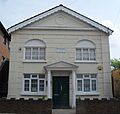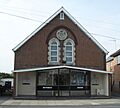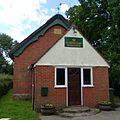List of places of worship in Horsham District facts for kids
The Horsham District in West Sussex, England, is home to many churches and other places of worship. The main town, Horsham, and the surrounding villages like Billingshurst, Henfield, Pulborough, Steyning, and Storrington have a long history of Christian faith. You can find many old Anglican churches, some built in Anglo-Saxon or Norman times. There are also Roman Catholic churches, including chapels within convents and even England's only Carthusian monastery.
Since the 1600s, other types of Protestant churches, known as Nonconformist churches, have also been important here. These include Plymouth Brethren, Baptists, Methodists, and United Reformed Church congregations. William Penn, a famous Quaker, lived and preached in this area, so there's still a strong Quaker presence. You can even find one of the last chapels of a unique local group called the Society of Dependants in Warnham. Horsham town also has a mosque.
Many of these religious buildings are very special, with nearly 50 of them having "listed status" from English Heritage. This means they are protected because they are important historically or architecturally. There are three levels of protection: Grade I for buildings of "exceptional interest," Grade II* for "particularly important" buildings, and Grade II for buildings of "special interest."
Contents
Exploring Places of Worship in Horsham District
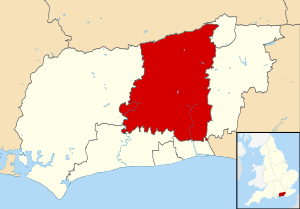
Horsham is a large, mostly countryside area in southeast England. It covers about 530 square kilometers (205 square miles) between the North Downs and South Downs. Much of it is part of the Weald, a wooded area, and many parts are protected as Areas of Outstanding Natural Beauty. Over a third of the people in the district live in the old market town of Horsham, which has grown a lot and now has about 45,000 residents. Other big villages include Billingshurst, Henfield, Pulborough, Steyning, and Storrington. Many of the 32 villages and hamlets in the district have very old churches, especially from the 1200s.
The Christian faith arrived in Sussex around the 600s with St Wilfrid. It became more widespread in the 700s when St Cuthman came to Steyning and started St Andrew's Church. The Weald, which was heavily forested, used to be a place for pagan worship. But by the 800s, Sussex was mostly Christian thanks to missionaries like Cuthman, who traveled around preaching and setting up places of worship.
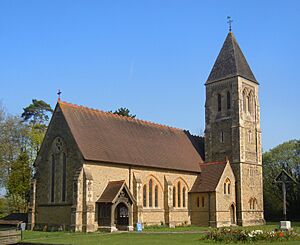
Many early churches in Sussex were simple, with just two main parts: a nave (where people sit) and a chancel (near the altar). As worship became more detailed and towns grew, many of these Saxon buildings were made bigger or rebuilt. So, many churches in Horsham District have Norman or early Gothic architecture styles.
During the Victorian era (1837-1901), many old churches were "restored" or updated. Sometimes these changes were quite big. This happened for a few reasons:
- New ideas in the Anglican church meant churches needed different features, like bigger chancels.
- Some churches were falling apart because they hadn't been looked after for a long time.
- More people living in bigger towns meant churches needed to be larger.
Architects like Gordon Macdonald Hills, Samuel Sanders Teulon, and George Gilbert Scott, Jr. worked on many of these old churches in the 1800s.
Roman Catholic worship has continued in the area since before the English Reformation (when England broke away from the Pope), even though it was against the law for many centuries. Wealthy families sometimes used secret rooms to hold Mass. You can still see an example of this at the Priest's House next to the Church of Our Lady of Consolation and St Francis in West Grinstead. Before permanent churches were built, Mass was sometimes held in private homes. Today, three of the district's Roman Catholic churches are connected to monasteries or convents, like St Hugh's Charterhouse Monastery at Parkminster.
Protestant Nonconformist groups have also had a long and successful history here. Many different denominations built chapels and meeting places from the 1600s to the 1800s, both in towns and in the countryside. Many of these buildings are still used today.
Methodist groups, especially the Wesleyan and Primitive Methodists, were very active in Horsham town. Wesleyan chapels also became popular in rural areas. The first Wesleyan chapel in Horsham was built in 1832. This led to new chapels in places like Southwater, Dragon's Green, Faygate, Mannings Heath, and Partridge Green. Some of these are still open today, like Steyning Methodist Church.
Baptist worship wasn't as widespread as in East Sussex, but Horsham town became a center for Strict and Particular Baptists in the 1800s, with three chapels: Hope, Rehoboth, and Jireh. General Baptists started in the 1660s under Matthew Caffyn. Members of the Horsham General Baptist Chapel (built in 1721) started a mission in Billingshurst in 1754. Both groups later became Unitarian, and their chapels are still in use.
The United Reformed Church, which was formed in 1972 by combining the Congregational Church and the Presbyterian Church of England, has four churches in the district. The Religious Society of Friends (Quakers) have been in the area since the 1600s, even when they faced difficulties. William Penn lived nearby and preached at places like a former meeting house in Steyning, now called Penn's House. The famous Blue Idol, a Quaker meeting place since 1691, is also in the area. Horsham Friends Meeting House dates from 1786.
Plymouth Brethren are also very active in Horsham town. Their first meeting house was started in 1863. Other places of worship for Christian Scientists, The Salvation Army, and Jehovah's Witnesses also exist.
The only non-Christian place of worship in the district is a mosque in Horsham town. The Muslim community found a permanent home for it in 2008, in a building that used to be the Jireh Independent Baptist Chapel.
Who Belongs to Which Religion?
According to the 2021 census, about 146,778 people live in Horsham district.
- Nearly half (49.28%) said they were Christian.
- A large number (42.08%) said they had no religion.
- About 0.87% were Muslim.
- Smaller numbers followed Hinduism (0.55%), Buddhism (0.4%), Jewish (0.19%), or Sikhism (0.07%).
- About 0.45% followed another religion, and 6.12% didn't say.
Compared to England as a whole, Horsham district has a higher percentage of Christians and people with no religion, and a lower percentage of other religions.
How Churches are Organized
Different types of churches have their own ways of organizing things.
- All Anglican churches in Horsham district are part of the Diocese of Chichester, which is led by the cathedral in Chichester. The district's churches are then divided into smaller groups called "deaneries." For example, churches in Horsham town and many surrounding villages are in the Rural Deanery of Horsham.
- The seven Roman Catholic churches in the district are managed by the Roman Catholic Diocese of Arundel and Brighton, whose cathedral is in Arundel. These churches are also grouped into deaneries.
- Some Baptist churches in the district are part of the South Eastern Baptist Association, which helps about 150 Baptist churches in southeast England.
Images for kids







































